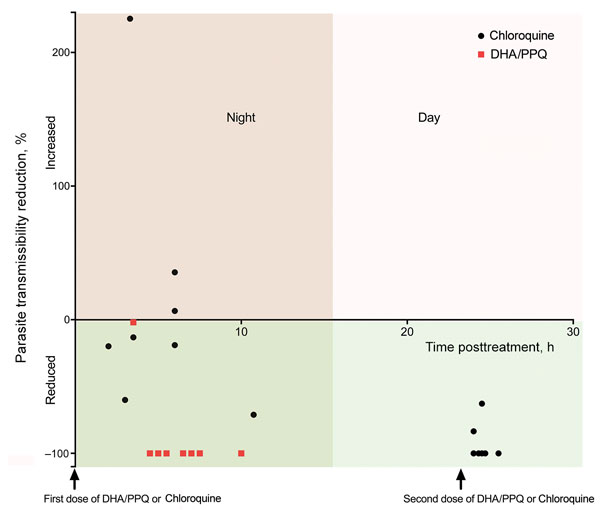Therapeutic and Transmission-Blocking
Efficacy of Dihydroartemisinin/Piperaquine and Chloroquine against Plasmodium vivax Malaria, Cambodia
Jean Popovici, Amelie Vantaux, Lyse Primault, Reingsey Samreth, Eak Por Piv, Sophalai Bin, Saorin Kim, Dysoley Lek, David Serre, and Didier Menard

Author affiliations: Institut Pasteur, Phnom Penh, Cambodia (J. Popovici, A. Vantaux, L. Primault, R. Samreth, E.P. Piv, S. Bin, S. Kim, D. Menard); National Center for Malaria Control, Phnom Penh (D. Lek); University of Maryland School of Medicine, Baltimore, Maryland, USA (D. Serre); Institut Pasteur, Paris, France (D. Menard)
Main Article
Figure 2

Figure 2. Transmission-blocking efficacy of allocated antimalarial drug treatment (chloroquine and DHA/PPQ) on human-to-mosquito transmission of Plasmodium vivax, January–March 2016, Cambodia. Each dot represents the parasite transmissibility reduction ratio (i.e., 100 – [proportion of infected mosquitoes fed with blood samples collected at 9:00 pm after the first dose of treatment × 100/proportion of infected mosquitoes fed with blood samples collected at patient enrollment before the first dose of treatment]). Only data of infectious patients at enrollment are shown (17/19 patients; Table 1). For the chloroquine-treated patient group, a second mosquito blood feeding was performed 24 h after the first dose. DHA/PPQ, dihydroartemisinin/piperaquine.
Main Article
Page created: July 17, 2018
Page updated: July 17, 2018
Page reviewed: July 17, 2018
The conclusions, findings, and opinions expressed by authors contributing to this journal do not necessarily reflect the official position of the U.S. Department of Health and Human Services, the Public Health Service, the Centers for Disease Control and Prevention, or the authors' affiliated institutions. Use of trade names is for identification only and does not imply endorsement by any of the groups named above.
